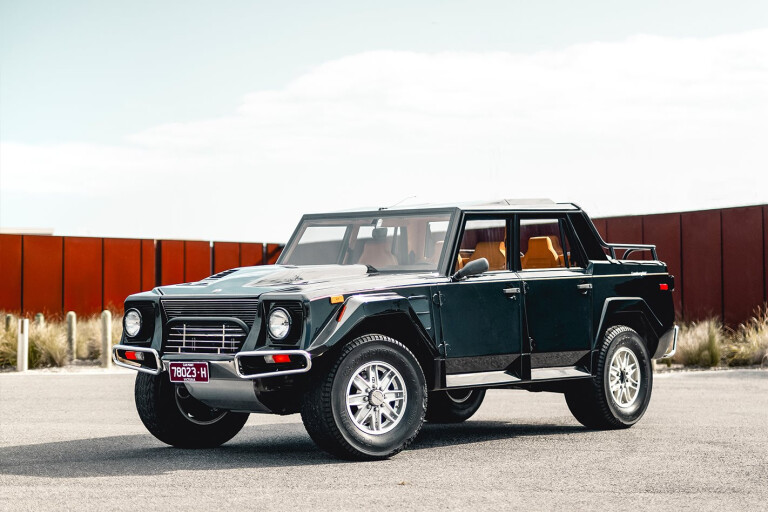
GENERAL GADDAFI loved his. Pablo Escobar’s was used to trundle around his backyard zoo. Uday Hussein’s was, like its registered keeper, extensively remodelled by the US military. You don’t have to be a poster child for the Levenson psychopathy scale to own a Lamborghini LM002, but it’s not a purchase that’s always rooted in stone-cold rationality.
Other owners have included Mike Tyson (hired a tax attorney for his rape trial), the Sultan of Brunei (assembled 7000 exotic cars and left most to rot ), Tina Turner (chose homeopathy over medicine, got kidney failure), Sylvester Stallone (thought smuggling drugs through Sydney Airport was a smart idea), and Keke Rosberg (had a moustache).
It’s no great surprise that the LM002 attracts some extreme types. It’s that sort of vehicle. Fittingly, its genesis came during the mid to late ’70s, Lamborghini’s most basket-case period. Just nine years after it built its first road car, Ferruccio Lamborghini sold 51 percent of the company to Swiss financier Georges-Henri Rossetti for $600,000 and, in 1974, divested the remaining 49 percent to Rossetti’s colleague René Leimer, retiring to the shores of Lake Trasimeno to tend his vines.
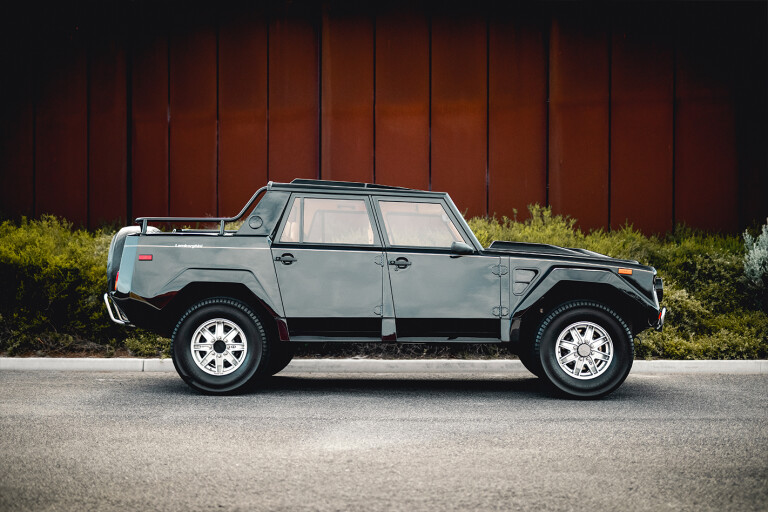
It’s hard to overstate the hole Lamborghini was in. It was a genuine catalogue of woe. The company tried to launch the Countach the year after the 1973 oil crisis broke. Neither the Countach nor the Silhouette V8 could be officially exported to the US in those early days. A contract to build the M1 for BMW was cancelled on April 20, 1978 when it was clear that Lamborghini was about to declare bankruptcy. The Bologna courts acquired the business later that year and would retain administration until 1980.
Enter Jean-Claude and Patrick Mimran, the third set of Swiss courtiers. These sugar-cane magnates were exactly the sort of eccentric fit the company needed. Jean-Claude was the self-styled ‘Sugar King of Africa’ while creative Patrick reached his artistic zenith with the world’s tallest giraffe sculpture. Most importantly, they had a seemingly bottomless fund of francs and ideas on how to revitalise the moribund manufacturer.
Under their management, the 4.8-litre Countach LP500S was approved for sale in the US, as was the successful Jalpa V8. The Bizzarrini V12 was teased out to 5.2 litres and given a multivalve head for the 1984 Countach LP5000 QV, but it was the 1986 LM002 that was perhaps their biggest left-fielder.

Lamborghini’s first tentative foray into this market came about as a partnership with the US contractor Mobility Technical International (MTI). In 1974, the American military was looking for a new high-mobility combat vehicle and MTI had a plan. The plan appeared to amount to copying the 1969 FMC XR311. This wasn’t a particularly successful military vehicle, failing to secure meaningful export orders and enjoying a production run of 20. Nevertheless, the template of a tubular steel chassis, rear-mounted Chrysler V8, three-speed TorqueFlite gearbox and a clever anti-puncture system proved attractive to MTI. With the benefit of hindsight, perhaps an Italian supercar manufacturer heading for receivership wasn’t the sagest choice of partners to manufacture what would be known as the Cheetah, and when it was unveiled at the 1977 Geneva Show, it seemed to attract more legal threats from FMC than it did solid orders.
Lamborghini and MTI parted company with the only surviving Cheetah being retained by its designer Rodney Pharis who later sold it to Teledyne Continental, the people who brought you the Patton tank. Once the Mimran brothers had taken the reins, engineering development boss Giulio Alfieri pulled the Cheetah project out of mothballs and set to work refining the design. The LM001, of which one sole example was built, retained the rear engine but gained a roof. The handling was, like the Cheetah, notably wayward and it was clear that in order to succeed, a radical rethink was required.
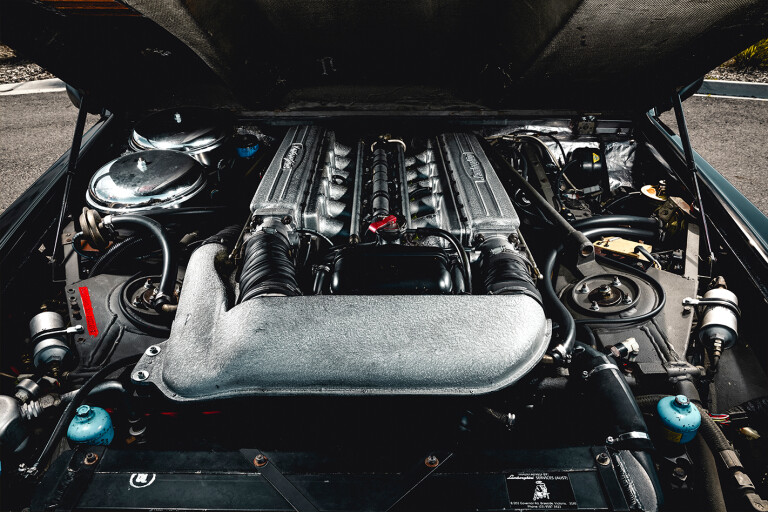
The putative solution appeared at the 1982 Geneva Show. The second Lamborghini Militaria vehicle, the LMA002 (‘A’ for anteriore, because the engine was now in front) featured Bizzarrini’s V12 powerplant wrapped in brutalist sheetmetal. Its gestation was nevertheless lengthy, Lamborghini courting military orders with demo vehicles displayed with gun mounts at the rear. An order of between 500 and 1000 vehicles from Saudi Arabia looked to have been secured, only to fall through at a late stage in negotiations. Phil Scott reported on the prototype for Wheels in September 1982, opining that here was a 4WD that “may just have given a new lease of life to the Bull of Sant’Agata.” Sounds familiar.
Rather than chase Middle Eastern military orders, the company decided that Middle Eastern playboys might be a more lucrative business demographic to pursue. The production LM002 was unveiled at the 1986 Brussels Show, now powered by the 48-valve Countach QV lump. Rather than a stripped-out, utilitarian interior for four troops, it was now swathed in leather, and was fitted with tinted electric windows, air-conditioning and a roof-mounted stereo. Run-flat Pirelli Scorpion tyres were one of the few conceptual carryovers from the original Cheetah.
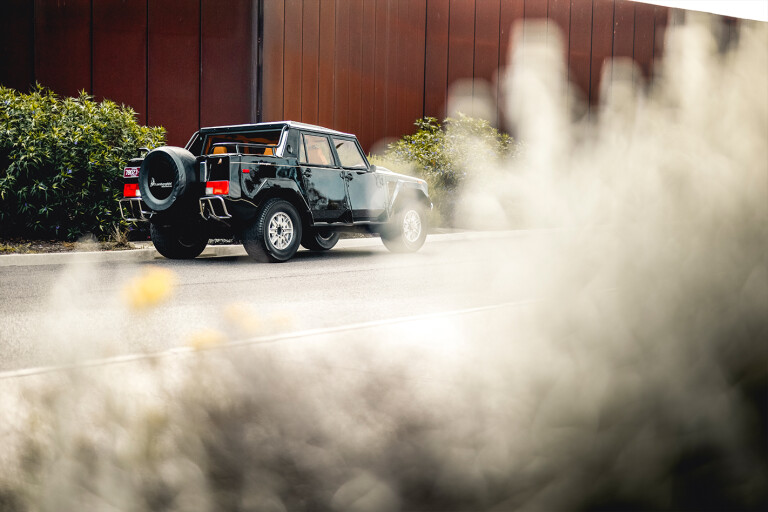
The odd thing about the LM002 is that from an utterly catastrophic development cycle came a genuinely noteworthy production car. Sure, only 328 ever found owners, and the Venn diagram of customers had quite an overlap between ‘owns pet tigers’ and ‘owns an LM002’, but the LM002 is such an event that its many idiosyncrasies are easy to overlook.
You’ll seat more people in a Clio than in the four-seat LM. While it’s truly vast on the outside, its 2000mm width meaning that you need to be very careful to avoid a protracted reversing out scenario, the cabin is snug due to a giant transmission tunnel. I had the chance to drive one in 2001 and the abiding memory is the fact that it feels cumbersome unless you really take charge and give the thing a good punt. The clutch requires a good kick and the steering seems to have a vague familiarity with the front tyres.
The huge wheel’s set at a bus-like angle of repose and is heavily power-assisted. Should you want to lock the freewheeling front hubs for off-road use, none of the constellation of fleshy buttons on the dash will do it. You get out and operate them manually. The high/low-range lever and locking rear diff can be operated without getting your sneakers muddy.

The V12 sounds magnificent, all carb-fed goodness and induction roar, but you never feel inclined to zing it to the redline as you would a Countach. The six Webers unleash a torrent of premium unleaded and the weighty, slow gearshift won’t have you blipping up and down through the ’box. Driving one hard on sealed surfaces can also chew through the standard 345-section Pirelli Scorpions, and replacements aren’t cheap. The turning circle is also truly hilarious.
It’s always an event, though. Most people have never seen one in the metal but a surprising number know exactly what it is and will give it the thumbs up. Perhaps because it is such a giant, profligate thing they see you driving it as an act of altruism, spreading the love at enormous personal sacrifice. Perhaps it’s the comical political incorrectness of the Lamborghini that can’t help but paint a smile on people’s faces.
Before the LM002 appeared, however, Lamborghini had been up a couple of design dead ends. In 1983, in an attempt to democratise the concept somewhat, Lamborghini fitted a 3.6-litre turbo-diesel built by VM Motori. Unsurprisingly, in the battle of 112kW versus 2700kg, weight won and the LM003 never made production. In 1984, Lamborghini experimented with the LM004, a demented lunge in the opposite direction, with even more luxury features and a 7257cc V12 that had been designed by Paolo Stanzani for powerboat racing, and which gave a claimed 313kW at 5400rpm. One prototype was built before Lamborghini settled on the lighter and more reliable Countach V12.
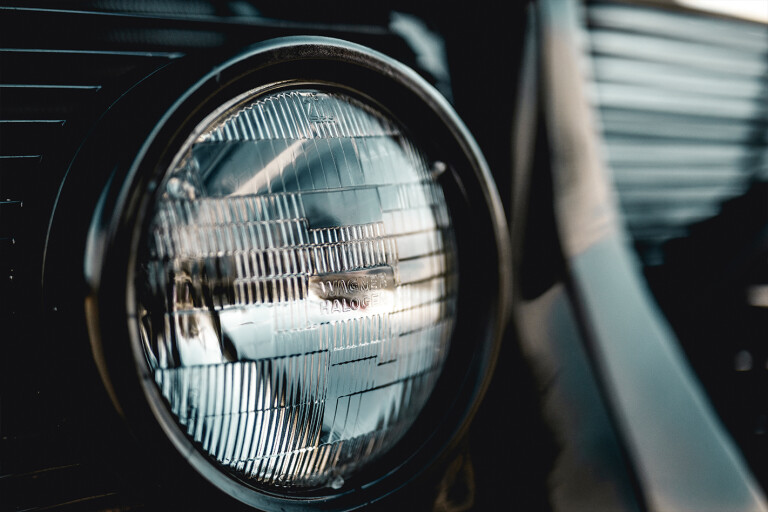
One often overlooked footnote in the LM002’s history is that it was Lamborghini’s first factory race car. Former F1 driver Henri Pescarolo first floated the idea of a rally raid version of the LM to the Mimrans, ostensibly to win the Paris Dakar rally. In 1986 the factory built a 441kW stripped-out desert racer, complete with a 600-litre fuel tank, but the LM002 Rally’s career proved ill-starred, recording a 100 percent DNF record.
The LM002’s final flourish came with 48 cars produced for the United States market, simply badged as the LM/American, an example of which you see pictured here. These fuel-injected cars are the best of the LM line but not the rarest. A seven-seat LM wagon was created in 1986 for the Sultan of Brunei and subsequently owned by BMW boss Bernd Pischetsrieder. Every LM002 is, in its own way, a one-off, and its legacy endures today, finally making good on its quest to deliver financial security to Lamborghini.
The LM002 represented the zeitgeist of pure ’80s excess better than any other Lamborghini. It made very little sense at the time and the whole project represented an exercise in throwing good money after bad. Nevertheless, its role in legitimising future SUV production at Sant’Agata is invaluable. The new Urus has a precedent; a bloodline. How do you put a price on that?

Who owns one? Jeff G – Melbourne
“This LM002 American was originally delivered into Newport Beach USA then ended up in a private collection in Southern Mexico . It was, with some difficulty, shipped back to the US and then on to Australia. It’s the only LM002 known of in Oz, and when replacement tyres are needed, you need to wait for Pirelli to make a batch. Fuel usage is not worth discussing but a 2700kg SUV that does 0-100 in 7.2 seconds and makes this much noise raises massive smiles.”
The Good: Sheer presence; mechanical durability; V12 soundtrack; well suited to Australian conditions; value’s only going one way
The Bad:Massive turning circle; certain spares are hugely expensive; tyres hard to come by; shocking fuel thirst; not that quick by today’s standards
Fast Fact
Uday Hussein’s LM002 came to an unfortunate end on July 18, 2004 on a US army base near Baquba, Iraq. A group of American soldiers, not realising the rarity of the Lamborghini, used it as a test vehicle to model the effects of a car bomb on a concrete barrier. Much of the LM was vaporised.
By the numbers
- ONE – right-hand drive LM002 in existence. Lives at Sant’Agata
- 169 – is the size of the fuel tank, which costs $280 to fill
- 24 – shocks killed in the 1996 Paris-Dakar DNF
- 1986-1992 – production span at a rate of one car per week
- LLA12298 – chassis number of 1990 LM002 blown up for Russian movie Brigada 2



COMMENTS